
In the ever-evolving landscape of the corporate world, one thing remains consistent: the paramount importance of human resource (HR) management. Whether you're steering the ship of a burgeoning startup or leading a team within a multinational giant, understanding the intricacies of HR is a game-changer. But why should a manager in, say, sales or IT concern themselves with HR dynamics? Simply put, human resources is the backbone of an organization, influencing every nook and cranny. While not everyone wears the HR title, the principles and skills of human resource management are universal, crossing departmental boundaries.
This article delves deep into the world of HR, tailored specifically for those who aren't directly in the HR realm but need to master its essentials. After all, people are the heart of any business, and managing them effectively is every manager's responsibility. So, even if "HR for non-HR" sounds a tad out of your wheelhouse, stick around—you're about to discover just how crucial and relevant it truly is.
HR for Non-HR: Why It Matters
Imagine this: You're an operations manager overseeing the day-to-day functionality of your company's product line. Your primary concerns are efficiency, quality control, and timely delivery. However, a conflict arises between two team members, which begins to affect production speed and overall morale. While it might seem like an HR problem, it's right at your doorstep. Why? Because HR issues are not just limited to the HR department. They permeate every layer, every team, and every project.
That's where the concept of "HR for non HR" comes into play. Even if HR isn't your primary responsibility, understanding its principles is vital for effective leadership. HR's tentacles spread much further than recruitment, payrolls, or benefits. It delves into team dynamics, conflict resolution, motivation, and so much more. For non-HR managers, gaining a foundational understanding of these concepts can mean the difference between a thriving, cohesive team and a disjointed one heading for a downfall.
Related Course: Leadership Development Course
Consider the global shift towards interdisciplinary roles. The lines separating different departments are blurrier than ever. Today's manager needs to be a jack-of-all-trades, melding their expertise with HR knowledge to get the best out of their teams. After all, isn't a manager's main role to manage people? And what better way to do so than by incorporating HR skills into their leadership style?
Real-life example: Sarah, a marketing manager, noticed a drop in her team's performance. Instead of pushing harder with strict deadlines or more meetings, she applied her basic HR training. She held one-on-one sessions, gauging individual concerns and stresses. This human-centric approach not only resolved underlying issues but also propelled the team's efficiency and creativity to new heights.
In essence, every manager is, in some capacity, an HR manager. The sooner this is realized and embraced, the smoother and more effective the managerial journey will be.
360-Degree Feedback: An In-depth Analysis of Its Implications & Impact
HR Auditing: Comprehensive Insight into Organizational Assessment
HR Research: Decoding the Imperative Role in Organizational Success
Nonhuman Resources Definition: Delineating HR from Other Roles
At its core, human resources is about people. It's the engine that drives recruitment, facilitates training, ensures workplace satisfaction, and, above all, cultivates a conducive environment for employees to thrive. But what about those tasks and roles that don't directly deal with HR? How do we delineate between traditional managerial responsibilities and those of an HR manager?
The term "non human resources" refers to areas of management that don't explicitly fall under the HR umbrella. Think financial forecasting, product development, market analysis, and so on. While these roles might seem miles apart from HR on the surface, there's a common thread that binds them - people.
Let's break it down:
A product manager, for instance, is tasked with bringing a product to life. This involves coordinating with various teams, understanding consumer needs and market trends, and ensuring timely product releases. While this role might be product-centric, the effectiveness of its execution heavily relies on human management. From collaborating with the design team to negotiating timelines with vendors, the product manager is constantly leveraging human management skills, even if indirectly.
Another example is the role of a financial analyst. Crunching numbers and predicting market trends might seem devoid of any HR influence. But when this analyst collaborates with teams, presents findings, or tries to persuade upper management to adopt a certain financial strategy, they're treading into the realm of human dynamics.
So, while "nonhuman resources" roles might have distinct objectives and KPIs, they're intrinsically tied to HR principles. Recognizing this overlap is crucial for holistic management. It empowers managers to not just excel in their primary tasks but also harness the power of effective human management, leading to richer collaborations, clearer communication, and a more harmonized workplace.
In essence, while we can categorize roles as HR or non-HR based on primary responsibilities, in the grand tapestry of organizational dynamics, the lines are beautifully interwoven. The magic lies in recognizing this and using it to one's advantage.
What is a Human Resource Manager: Breaking Down the Role
For many outside the HR realm, the title "Human Resource Manager" might evoke images of interviews, onboarding sessions, and perhaps the occasional conflict resolution. But is that all there is to this pivotal role? Let's dissect the multifaceted responsibilities and impact of an HR manager in today's corporate environment.
Job Description of an HR Manager:
At its heart, a Human Resource Manager is the custodian of an organization's most valuable asset - its people. They act as the bridge between the workforce and the company's objectives, ensuring both parties thrive symbiotically. Their job is not just administrative but also strategic.
Key Responsibilities:
Recruitment and Onboarding: Beyond just hiring, it's about finding the right fit for the company's culture and future. It's a blend of foresight, understanding job requirements, and gauging a candidate's potential.
Training and Development: It's not just about orientation sessions. HR managers identify skill gaps, arrange training sessions, and ensure employees grow in their roles, benefiting both the individual and the organization.
Employee Relations: This goes beyond resolving conflicts. It's about cultivating a positive work environment, ensuring open communication channels, and fostering trust between employees and management.
Compensation and Benefits: Beyond paychecks, HR managers ensure that employee benefits are competitive, fair, and in line with the company's objectives and resources.
Legal Compliance: They ensure that the company adheres to labor laws, thus protecting the organization from potential legal pitfalls.
Strategic Planning: They play a crucial role in shaping the company's direction by advising on the human element in business strategies, from mergers and acquisitions to expansions.
Real-life example: Alex, an HR manager at a tech startup, identified a trend of employees feeling burnt out. Instead of taking a passive approach, he spearheaded an initiative to introduce flexible working hours and mental health days. The result? A noticeable uptick in employee morale and productivity, and even a positive shift in company culture.
In essence, the role of a Human Resource Manager is like that of a conductor in an orchestra, ensuring every section comes together harmoniously. They don't just manage people; they shape the very essence of the organization. So, the next time you think about an HR manager, remember they're not just filling seats—they're crafting the future of the organization.
Essential "HR Skills" Every Manager Should Know
Whether you're at the helm of a finance team or spearheading a marketing campaign, a foundational understanding of human resource skills can be your secret weapon. Why? Because every role, at its core, is about managing, influencing, or collaborating with people. Here's a dive into some HR skills that every manager, irrespective of their primary role, should have up their sleeve.
Communication:
This isn't just about speaking clearly. It's the art of conveying ideas, giving feedback, and listening actively. Effective communication fosters transparency and trust, making collaboration seamless.
Conflict Resolution:
Differences in opinion are inevitable in a team. But turning these differences into constructive dialogues rather than disruptive arguments? That's where adept conflict resolution comes into play.
Team Building:
Creating a cohesive team isn't an overnight feat. It requires understanding individual strengths, fostering a sense of belonging, and cultivating a shared vision.
Understanding Employee Needs:
Are your team members satisfied? What drives them? A keen understanding of these needs can aid in motivation, retention, and overall team performance.
Adaptability:
The corporate landscape is ever-evolving. Being adaptable ensures that managers can navigate changes, be it in team dynamics, company objectives, or market demands.
Legal and Ethical Know-How:
While deep expertise might be the HR department's realm, a basic understanding ensures that decisions are compliant and ethically sound.
Real-life example:
Mira, a team lead in a design agency, noticed a dip in her team's enthusiasm. Leveraging her HR skills, she organized a workshop that not only honed their design skills but also incorporated team-building exercises. This not only rejuvenated their passion but also strengthened team bonds, leading to better collaborations on future projects.
It's clear that HR skills are not just the domain of human resource professionals. They are universal tools that can elevate the way any manager interacts with and leads their team. So, even if you're not directly involved in human resources, these skills offer a roadmap to managerial excellence. Because, at the end of the day, management is all about people. And what better way to manage people than with a touch of HR brilliance?
Human Management Skills" Beyond Traditional HR
When we talk about management, it's easy to get bogged down by KPIs, project timelines, and deliverables. But strip away the jargon, and the core remains: humans managing humans. In this maze of human dynamics, traditional HR skills are the compass. However, there are more nuanced "human management skills" that go beyond traditional HR knowledge but are equally pivotal for any manager.
Emotional Intelligence (EI):
Gone are the days when decisions were purely data-driven. Today, a manager's EI - their ability to recognize, understand, and manage their own emotions while also being sensitive to others - is a cornerstone. It fosters empathy, a deeper understanding of team dynamics, and a more humane approach to problem-solving.
Motivational Tactics:
Understanding what drives each team member, celebrating small wins, and creating an environment where each person feels valued isn't just HR – it's leadership.
Understanding Group Dynamics:
Every team has its own rhythm, a unique blend of personalities and skills. Recognizing this mix and leveraging it effectively can spell the difference between a disjointed team and a harmonious one.
Feedback Mechanisms:
Constructive feedback, when delivered correctly, can catalyze growth. It's about striking the right balance between critique and encouragement.
Cultural Sensitivity:
With the global nature of businesses today, managers often find themselves leading diverse teams. An understanding and respect for cultural nuances can lead to richer collaborations and a more inclusive work environment.
Real-life example:
Jake, a project lead in a global software company, had team members from six different countries. Instead of a one-size-fits-all approach, he took the time to understand each member's cultural background and work preferences. This not only led to a harmonious team environment but also brought diverse perspectives to the project, enriching its outcome.
To sum it up, while traditional HR skills lay the foundation, it's these human management skills that build the structure. They bring depth to interactions, a touch of humanity to decisions, and, most importantly, transform a good manager into an exceptional leader. Because in the world of management, understanding the project is crucial, but understanding the people? That's the game-changer.
Applicant Tracking System Benefits For Efficient Candidate Management
Long Tail Keyword: Hr Vendor Management Strategies For Optimal Efficiency
Role of HR Manager: Navigating the Organizational Labyrinth
We've talked about what an HR manager is and the skills every manager should possess. But how does an HR manager apply these skills in the practical, day-to-day operations of a bustling organization? Let's take a deep dive into the pivotal role of HR managers, the captains steering the ship of an organization's human capital.
Strategic Partnering:
Gone are the days when HR was just a support function. Today, HR managers are at the strategy table, ensuring that business goals align with human potential. They're the ones connecting organizational objectives with employee performance, ensuring a symbiotic relationship.
Talent Acquisition and Retention:
An HR manager isn't just hiring; they're strategically acquiring talent. They spot potential and ensure cultural fit, and once the talent is on board, they work tirelessly to retain them, understanding that in the modern job market, retention is as crucial as recruitment.
Performance Management:
Beyond yearly appraisals, HR managers establish continuous feedback loops. They set clear performance metrics, monitor progress, and ensure employees have the resources and training to meet and exceed these metrics.
Learning and Development:
The modern HR manager knows that static teams have become obsolete. They're constantly identifying learning opportunities ensuring teams are trained in the latest industry practices, technologies, and soft skills.
Employee Engagement and Well-being:
More than just organizing team lunches or outings, HR managers are the guardians of employee morale. They run surveys, hold focus groups, and ensure that the organization is a space where employees feel valued, heard, and motivated.
Real-life example:
Sophia, an HR manager in a mid-sized fintech firm, recognized early on the signs of digital fatigue in her remote team. Instead of waiting for yearly surveys, she quickly instituted digital detox days, encouraging employees to unplug and recharge. This not only boosted morale but also increased overall productivity, as employees returned to work more refreshed and motivated.
The role of an HR manager is like a tightrope walker, balancing organizational objectives on one side and employee well-being on the other. They're the pulse-keepers, ensuring that the heart of the organization, its people, beats in rhythm with its goals. In the grand theatre of an organization, while various departments might play their parts, it's the HR manager who ensures that the show goes on seamlessly and harmoniously.
Basic HR Knowledge: The Building Blocks of Human Resource Mastery
It's evident that the world of human resources is expansive and multifaceted. However, for those new to the realm or those from non-HR backgrounds aiming to grasp the essence of human resource management, there are some foundational principles to be aware of. These building blocks provide a robust platform to dive deeper into the vast ocean of HR.
Employment Law & Ethics:
Every decision in HR, be it hiring, firing, or conflict resolution, is governed by a framework of laws and ethical guidelines. This ensures fair treatment of employees and protects companies from potential legal troubles.
Recruitment & Selection:
This isn't just about filling vacancies but finding the right candidate who aligns with the company's ethos and has the potential for growth. It's a mix of art (gauging a candidate's personality and potential) and science (assessing skills and experience).
Training & Development:
Ensuring that employees are equipped with the necessary skills, not just for their current roles but also for future challenges, is crucial. This involves continuous learning and adapting to industry changes.
Compensation & Benefits:
Rewarding employees fairly is central to HR. This involves crafting competitive salary packages, performance bonuses, and other perks that motivate and retain talent.
Employee Relations & Engagement:
Building a positive workplace culture where employees feel valued, heard, and engaged is essential for productivity and retention.
Performance Management:
It's about setting clear expectations, providing feedback, and ensuring that employees have the right resources and environment to excel in their roles.
Real-life example:
When Rajiv transitioned from a technical lead to a managerial role in his IT firm, he quickly realized that technical know-how alone wouldn't cut it. To ensure his team's success, he took a short course covering basic HR knowledge. This foundation helped him understand the needs and aspirations of his team members better, leading to improved team dynamics and project outcomes.
In conclusion, while the intricacies of HR can be vast and complex, the foundational knowledge provides a strong anchor. Whether you're an aspiring HR professional or a manager wanting to enhance your team leadership capabilities, understanding these basics is a stepping stone to mastering the human side of business. After all, businesses don't succeed; people do. And understanding people is the essence of HR.
HR for Non-HR: Bridging the Knowledge Gap
In today's fluid organizational structures, interdisciplinary knowledge is not just an asset; it's a necessity. As roles blur and responsibilities intertwine, managers from non-HR backgrounds often find themselves wearing the HR hat, be it during team conflicts, recruitment processes, or even talent retention strategies. So, how can someone from, say, a pure finance or marketing background bridge the gap and embrace the "HR for non-HR" mantra?
Understanding HR Lingo:
While you don't need to know every term, understanding basic HR jargon can aid in smoother communications with the HR department and employees alike. Terms like onboarding, talent pipeline, and employee engagement should be on your radar.
Engage in Cross-Training:
Many organizations offer cross-training opportunities. Enrolling in a few basic HR courses or workshops can provide a foundational understanding and boost confidence in handling people-centric issues.
Collaborate with HR Teams:
Regularly checking in with your HR department can offer insights into best practices. They can provide guidance, resources, and tools that can help you navigate HR-related challenges more effectively.
Empathy is Key:
One doesn't need an HR degree to be empathetic. Understanding and addressing the emotions, aspirations, and concerns of your team can often resolve many issues even before they escalate.
Stay Updated on HR Trends:
The world of HR, like all fields, is evolving. Subscribing to HR newsletters or following relevant HR platforms can keep you abreast of the latest trends and best practices.
Real-life example:
Liam, a sales manager with a decade of experience in his field, suddenly found himself leading a team that spanned four countries. Realizing the cultural and HR challenges ahead, he took a short online course on "HR for non-HR managers." This not only equipped him to handle team dynamics more efficiently but also made him a favorite among his team members for his understanding and inclusive leadership style.
In a nutshell, while diving deep into the HR ocean might seem daunting for non-HR professionals, it's not about mastering every nuance. It's about having a basic toolkit and the right mindset to manage and lead teams more effectively. Remember, in the heart of every role, HR or not, lies the same core component: people. And understanding them can be your biggest strength.
Nonhuman Resources Definition: A Shift in Perspective
Given all our discussions on human resources, it's intriguing to ponder the term "nonhuman resources." While it may initially seem like an antithesis, understanding this concept can be pivotal in offering a more holistic view of organizational management.
Defining Nonhuman Resources:
At its core, nonhuman resources refer to all tangible and intangible assets of an organization, excluding its human capital. This can encompass physical assets (like machinery, office space, or products), financial assets (such as capital or cash reserves), and intangible assets (like brand reputation, intellectual property, or organizational culture).
The Interplay with HR:
While distinct, human and nonhuman resources are deeply interconnected. For instance, the best talents can't perform optimally without the right tools (nonhuman resources) at their disposal. Conversely, the most advanced machinery is of little use without a skilled operator.
Optimizing Nonhuman Resources:
Just as HR managers are tasked with hiring, training, and retaining talent, there are managers dedicated to ensuring that nonhuman resources are optimized, maintained, and aligned with organizational goals.
The Balance Act:
A successful organization seamlessly balances its human and nonhuman resources. It's about ensuring that employees have the right tools to perform their roles and that these tools are leveraged by skilled, motivated, and engaged employees.
Real-life example:
Consider a tech startup. They might have the latest software (nonhuman resources) to develop cutting-edge apps. However, without a team of skilled developers and marketers (human resources), this software might remain underutilized. Conversely, having a top-notch team without the necessary tools can lead to inefficiencies and missed opportunities.
To wrap it up, while the distinction between human and nonhuman resources is clear, their interdependence is undeniable. In the grand scheme of organizational success, both play pivotal roles. It's not about prioritizing one over the other but harmonizing their synergy. After all, in the intricate dance of organizational growth, both human and nonhuman resources must move in tandem, complementing and elevating each other.
Conclusion: The Harmonious Symphony of HR and Beyond
As we've traversed the multifaceted world of human resource management, one thing stands clear: HR isn't just about hiring and firing. It's a rich tapestry of skills, responsibilities, and understanding pivotal to the success of any organization. From grasping the nuances of HR for non-HR professionals to the delicate balance between human and nonhuman resources, the domain's depth and breadth are undeniable.
For those intrigued by this exploration and keen to delve deeper, a course in human resources can be an invaluable step. It not only solidifies foundational knowledge but also offers insights into the latest trends, challenges, and innovations in the realm of HR.
In essence, whether you're an HR professional, a manager from a non-HR background, or simply someone fascinated by the dynamics of organizational management, remember this: At the heart of every successful organization lies its people. And understanding, nurturing, and leading them is both an art and a science. As the world of work continues to evolve, so does the role of HR, standing firm as the beacon guiding this evolution.

Frequently Asked Questions
1. What are the key HR skills every manager should possess?
As a manager, possessing key HR skills is crucial for effectively leading and managing your team. These skills enable you to navigate the complexities of human resources and create a positive work environment.
Communication and Interpersonal Skills
Managers must be excellent communicators, both verbally and in writing. They should actively listen to their team members, provide clear instructions, and offer constructive feedback. Building strong relationships with employees through empathy, trust, and respect is essential.
Example from my experience:
In my previous role as a marketing manager, I made it a priority to have regular one-on-one meetings with each team member. During these meetings, I actively listened to their concerns, ideas, and aspirations. By fostering open communication, we built a strong sense of trust and collaboration within the team.
Conflict Resolution and Problem-Solving
Conflicts and challenges are inevitable in any workplace. Managers should be skilled in identifying issues, analyzing situations objectively, and finding effective solutions. They must be able to mediate conflicts and facilitate productive conversations between team members.
Personal story:
I once had to deal with a conflict between two team members who had differing opinions on a project's direction. By bringing them together and facilitating an open discussion, we were able to find a compromise that satisfied both parties and moved the project forward successfully.
Leadership and Motivation
Great managers inspire and motivate their teams to achieve their best. They lead by example, setting clear goals and expectations. Recognizing and rewarding employee achievements, providing growth opportunities, and creating a positive team culture are key aspects of effective leadership.
My thoughts:
I believe that leadership is about empowering others to succeed. When I lead a team, I focus on identifying each individual's strengths and providing them with the support and resources they need to excel. Celebrating successes, no matter how small, helps keep the team motivated and engaged.
Adaptability and Continuous Learning
In today's rapidly changing business landscape, managers must be adaptable and open to continuous learning. Embracing new technologies, staying updated with industry trends, and being receptive to feedback are essential for personal and team growth.
Personal example:
When our company introduced a new project management software, I took the initiative to learn it inside out. I then conducted training sessions for my team, ensuring that everyone was comfortable with the new tool. By being adaptable and proactive in learning, we were able to streamline our processes and boost productivity.
Developing and mastering these key HR skills takes time and effort, but it is a worthwhile investment for any manager. By prioritizing effective communication, problem-solving, leadership, and adaptability, you can create a positive and productive work environment that brings out the best in your team.

2. How can managers effectively communicate with their team members?
As a manager, I believe that effective communication is the foundation of a successful team. Over the years, I've learned that managers can foster open and productive communication in several ways:
Lead by Example
Managers should model the communication style they expect from their team. Be clear, concise, and respectful in your interactions. When you set a positive example, your team will follow suit.
Listen Actively
Active listening is crucial for managers. Give your full attention to team members when they speak. Ask clarifying questions and provide feedback to show that you value their input.
Provide Regular Feedback
Don't wait for annual reviews to give feedback. Offer constructive criticism and praise regularly. This helps team members grow and feel valued.
Use Multiple Communication Channels
People have different communication preferences. Use a mix of face-to-face meetings, emails, instant messaging, and phone calls to cater to everyone's needs.
Encourage Open Dialogue
Create a safe space where team members feel comfortable sharing ideas and concerns. Encourage questions and feedback. This fosters trust and collaboration.
Be Transparent
Share information openly with your team. Keep them informed about company goals, challenges, and successes. Transparency builds trust and engagement.
In my experience, implementing these strategies has led to more effective communication and stronger team bonds. By prioritizing open, honest, and respectful communication, managers can create a positive and productive work environment.
3. What strategies can managers use to motivate their team?
As a manager, keeping your team motivated is crucial for achieving goals and fostering a positive work environment. Here are some effective strategies to inspire and engage your team members:
Lead by Example
I've found that demonstrating a strong work ethic and positive attitude is incredibly powerful. When you're passionate about what you do, it's contagious. Your team will feel more driven when they see you rolling up your sleeves and tackling challenges head-on.
Recognize and Reward
Never underestimate the impact of acknowledging a job well done. Whether it's a simple "thank you" or a more formal recognition program, showing appreciation for hard work and dedication goes a long way. I remember how valued I felt when a manager took the time to personally praise my efforts on a difficult project.
Provide Growth Opportunities
Investing in your team's professional development is a win-win. Offer training, mentorship, and chances to take on new responsibilities. When people feel like they're learning and advancing in their careers, they're more likely to stay engaged and committed to their work.
Foster Open Communication
Create an environment where everyone feels heard and valued. Encourage open dialogue, actively listen to ideas and concerns, and be transparent about company goals and decisions. I've found that regular check-ins and team meetings help keep everyone on the same page and feeling connected.
Set Clear Goals
People are more motivated when they understand how their work contributes to the bigger picture. Set specific, measurable, achievable, relevant, and time-bound (SMART) goals for your team. Break them down into smaller milestones and celebrate progress along the way.
Remember, every team is unique, so it's important to adapt your approach based on individual needs and preferences. By consistently employing these strategies and genuinely caring about your team's success, you'll create a motivated and high-performing workforce.
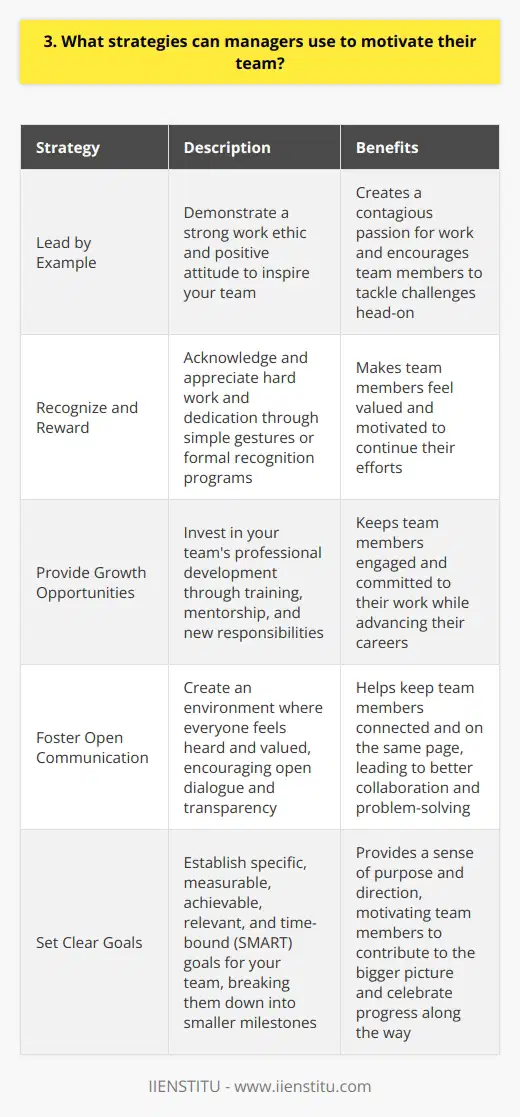
4. How can managers identify and develop high-potential employees?
As a manager, identifying and developing high-potential employees is crucial for the success of your team and organization. Here are some strategies I've found effective:
Observe Performance and Potential
Pay close attention to your employees' work and look for signs of exceptional performance and growth potential. Do they consistently exceed expectations, take initiative, and demonstrate leadership skills? These are good indicators of high potential.
Provide Opportunities for Growth
Give promising employees challenging assignments and projects that stretch their abilities. This allows them to develop new skills, gain exposure to different areas of the business, and demonstrate their potential. I once gave a high-potential employee the chance to lead a cross-functional project, and she absolutely shined!
Offer Mentoring and Coaching
Pair high-potential employees with experienced mentors who can guide their development. Regular coaching sessions help them set goals, overcome obstacles, and accelerate their growth. I've seen firsthand how transformative a great mentor-mentee relationship can be.
Encourage Continuous Learning
Support your high-potential employees' desire to learn and grow. Provide access to training programs, workshops, and conferences that align with their development goals. When you invest in their education, you demonstrate your commitment to their future.
Recognize and Reward
Acknowledge the achievements and contributions of your high-potential employees. Public recognition, promotions, and expanded responsibilities show that you value their efforts and see them as future leaders. A little appreciation goes a long way in keeping them engaged and motivated.
Remember, every employee has unique strengths and aspirations. By taking the time to identify and nurture high-potential talent, you'll build a pipeline of future leaders who will drive your organization forward.
5. What are the best practices for conducting performance reviews?
As a manager, I believe that conducting effective performance reviews is crucial for employee growth and development. Throughout my career, I've learned that the best practices for performance reviews involve:
Setting Clear Expectations
Before the review, employees should know exactly what is expected of them. I always make sure to communicate goals and objectives clearly, so there are no surprises during the evaluation.
Gathering Feedback from Multiple Sources
To gain a well-rounded perspective, I collect feedback from colleagues, subordinates, and even clients who have worked closely with the employee. This 360-degree approach helps me see the full picture of their performance.
Focusing on Specific Examples
During the review, I focus on specific instances where the employee demonstrated strengths or areas for improvement. I find that using concrete examples makes the feedback more actionable and easier to understand.
Encouraging Open Dialogue
I believe that performance reviews should be a two-way conversation. I always encourage employees to share their thoughts, ask questions, and provide their own feedback. This creates a more engaging and productive discussion.
Creating an Action Plan
At the end of the review, I work with the employee to create a clear action plan for the future. We set measurable goals and discuss the support and resources they need to achieve them.
In my experience, following these best practices has led to more meaningful and effective performance reviews. It's not always easy, but I've seen firsthand how this approach can help employees grow and thrive in their roles.
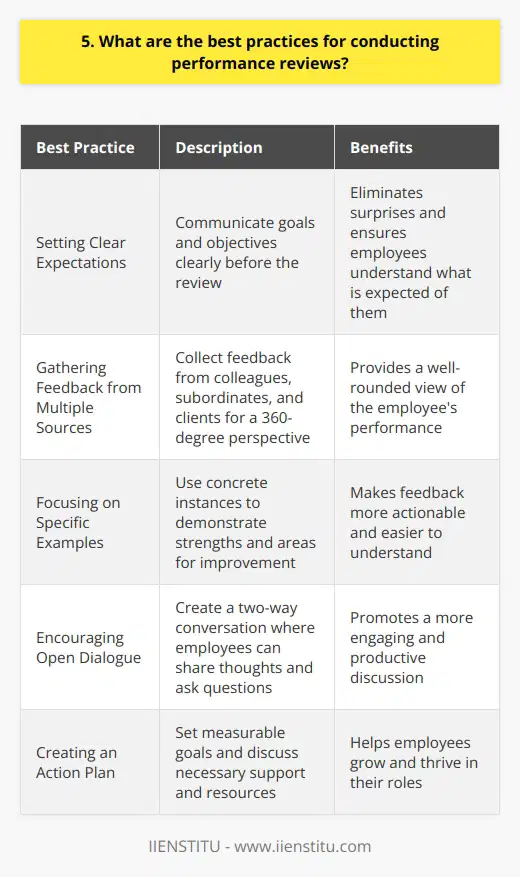
6. How can managers handle conflicts within their team?
As a manager, it's crucial to address conflicts within your team promptly and effectively. Here are some strategies I've found helpful:
Listen actively and remain impartial
When a conflict arises, gather information from all parties involved. Give each person a chance to share their perspective without interruption. Avoid taking sides or making judgments until you have a complete understanding of the situation.
Identify the root cause
Often, conflicts stem from underlying issues like miscommunication, differing priorities, or resource constraints. Work with the team to pinpoint the true source of the problem. Asking open-ended questions can help uncover hidden factors contributing to the disagreement.
Encourage collaboration and compromise
Once the root cause is identified, bring the conflicting parties together to brainstorm solutions. Encourage them to focus on their shared goals and find common ground. Guide the conversation towards a mutually beneficial compromise that addresses everyone's concerns.
Follow up and monitor progress
After a resolution is reached, check in regularly with the team to ensure the agreed-upon solution is implemented effectively. Offer support and guidance as needed, and be prepared to intervene if the conflict resurfaces or new issues arise.
In my experience, approaching conflicts with empathy, openness, and a focus on collaboration yields the best outcomes. By creating a safe space for honest communication and problem-solving, managers can turn conflicts into opportunities for growth and strengthened team dynamics.
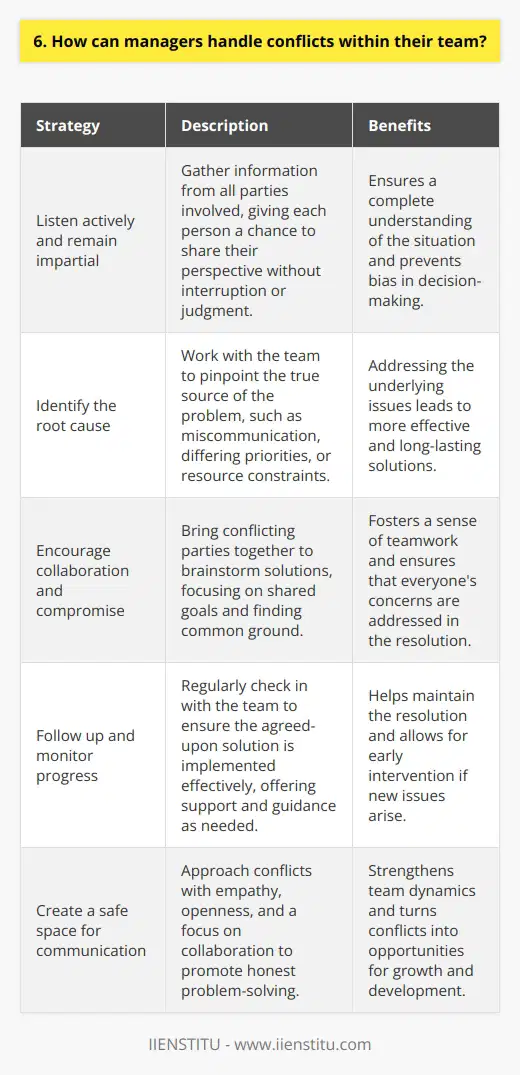
7. What are some effective ways to delegate tasks to team members?
When delegating tasks to team members, it's essential to consider each individual's strengths, skills, and workload. By assigning tasks that align with their abilities, you can ensure that the work is completed efficiently and effectively.
Communicate clearly
Provide detailed instructions and expectations when delegating tasks. Make sure your team members understand what needs to be done, the deadlines, and any specific requirements. Clear communication helps avoid misunderstandings and ensures that everyone is on the same page.
Empower your team
Trust your team members to take ownership of their assigned tasks. Give them the autonomy to make decisions and solve problems on their own. Empowering your team not only boosts their confidence but also allows them to develop their skills and grow professionally.
Provide support and resources
Make sure your team has access to the necessary resources and support to complete their tasks successfully. Be available to answer questions, provide guidance, and remove any obstacles that may hinder their progress. Your role as a leader is to facilitate their success.
Follow up and give feedback
Regularly check in with your team to monitor their progress and offer feedback. Acknowledge their achievements and provide constructive criticism when necessary. Consistent follow-up helps keep everyone accountable and ensures that tasks are completed on time and to the required standards.
In my experience, effective delegation has been crucial in managing projects and leading teams. By assigning tasks based on individual strengths, providing clear instructions, and offering support, I've seen my team members thrive and deliver exceptional results.

8. How can managers foster a positive work environment?
As a manager, fostering a positive work environment is crucial for employee satisfaction and productivity. Here are some strategies I believe can help:
Lead by Example
Managers should embody the values and behaviors they want to see in their team. By maintaining a positive attitude, being respectful, and treating everyone fairly, managers set the tone for the entire workplace. When I was working at my previous company, my manager always greeted everyone with a smile and took the time to listen to our concerns. This created a warm and welcoming atmosphere that made us feel valued and motivated to do our best work.
Encourage Open Communication
Creating an environment where employees feel comfortable expressing their ideas, concerns, and feedback is essential. Managers should have an open-door policy and regularly check in with their team members. I remember a time when I was feeling overwhelmed with my workload, and my manager noticed my stress. She took me aside and asked me what was going on. By actively listening and offering support, she helped me find solutions and feel more at ease.
Recognize and Celebrate Achievements
Acknowledging and rewarding employees for their hard work and successes can boost morale and motivation. Managers should make a point to celebrate both individual and team accomplishments, no matter how small. This could be through verbal praise, written notes, or even small tokens of appreciation. I once had a manager who would bring in bagels and coffee for the team every time we hit a major milestone. It was a simple gesture, but it made us feel appreciated and energized to keep pushing forward.
Foster Collaboration and Teamwork
Encouraging employees to work together and support one another can create a sense of camaraderie and shared purpose. Managers should provide opportunities for team building and collaboration, such as group projects or brainstorming sessions. When I was part of a cross-functional team working on a complex project, my manager made sure to bring us together regularly to share updates, exchange ideas, and offer help where needed. This fostered a strong sense of unity and trust among team members, which ultimately led to the project's success.
By implementing these strategies, managers can create a positive work environment that promotes employee well-being, engagement, and productivity.
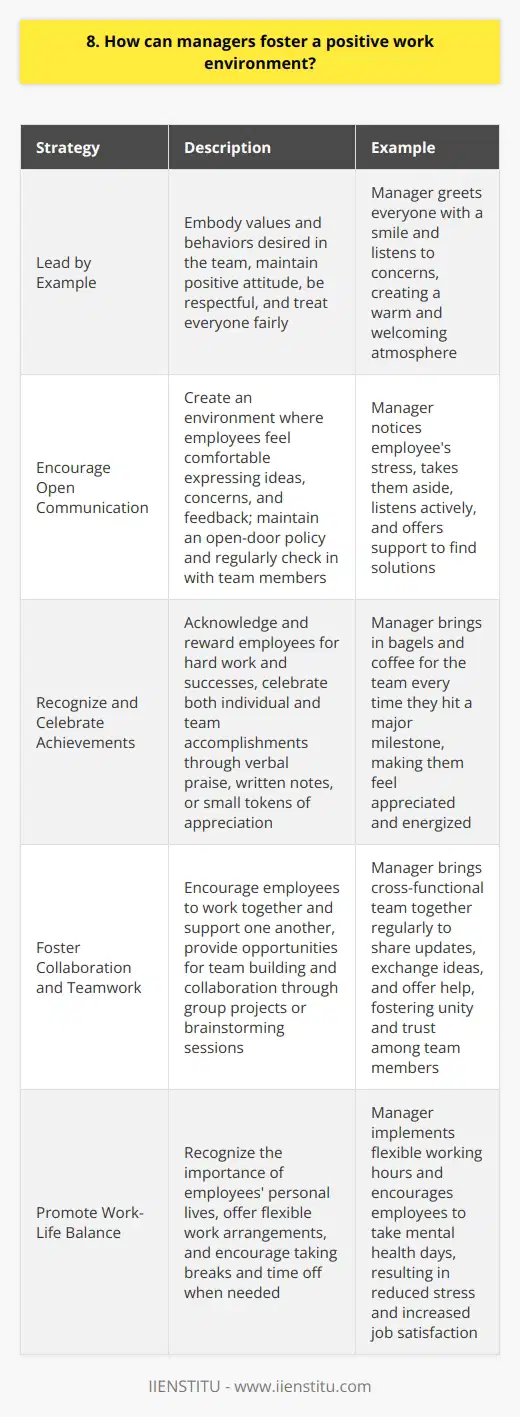
9. What are the essential steps in the hiring process?
The essential steps in the hiring process are crucial for finding the right candidate for a job. Here's what I've learned from my own experiences and observations:
Identifying the Need
First, the company must determine what role they need to fill and why. This involves analyzing workload and goals.
Creating a Job Description
Next, HR or the hiring manager crafts a detailed description of the position's responsibilities, qualifications, and desired skills.
Posting the Job
The job ad is posted on the company website, job boards, and social media to attract a pool of candidates.
Reviewing Applications
As resumes come in, HR screens them for the most qualified applicants who match the job requirements well.
Conducting Interviews
Selected candidates are invited for interviews, usually starting with a phone or video screening, then in-person meetings.
Making a Decision
After interviews, the hiring team discusses the candidates and chooses the best fit based on skills, experience, and personality.
Extending an Offer
HR contacts the top candidate to offer them the position, discuss salary and benefits, and agree on a start date.
Onboarding
Finally, the new hire completes paperwork, training, and orientation to integrate into the company and begin contributing.
I find the hiring process fascinating because it's a bit like matchmaking - linking the right people to the right roles. When it works well, everyone benefits. The company gains a valuable employee, the new hire finds a fulfilling job, and the team gets a strong new member. It can be a long road, but so worthwhile in the end.
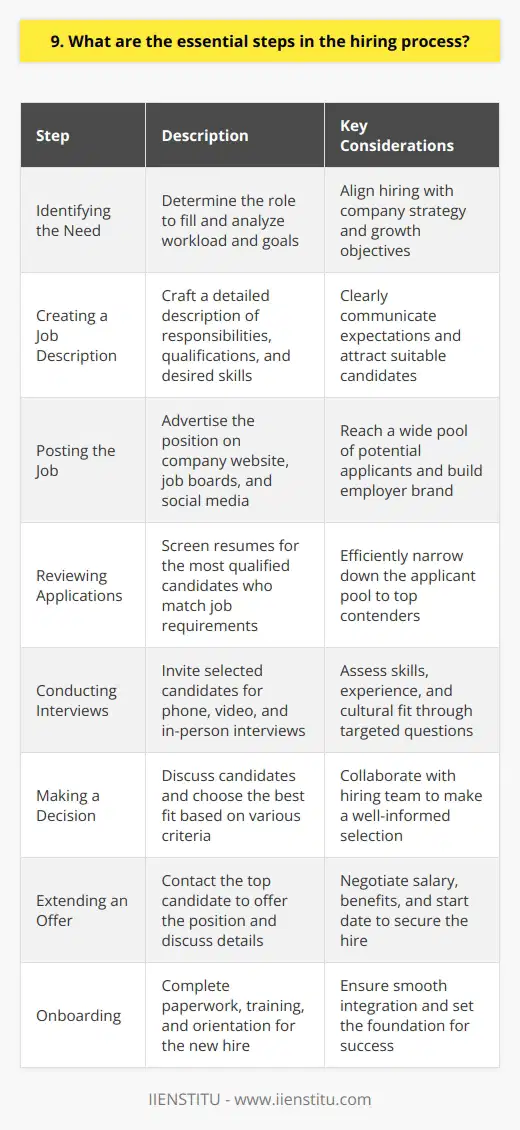
10. How can managers ensure a fair and unbiased recruitment process?
As a hiring manager, I believe that ensuring a fair and unbiased recruitment process is crucial. It's not always easy, but there are several steps we can take to make it happen.
Develop Clear Job Descriptions and Criteria
One of the most important things is to develop clear, detailed job descriptions and criteria for evaluating candidates. This helps ensure that we're assessing everyone based on the same standards and not letting personal biases influence our decisions.
Use Structured Interviews
Structured interviews, where each candidate is asked the same set of predetermined questions, can also help reduce bias. It keeps the focus on job-related factors rather than subjective impressions.
Involve Multiple Interviewers
Having multiple interviewers, ideally from different backgrounds, participate in the process is another good practice. It provides diverse perspectives and makes it harder for one person's biases to dominate.
Anonymize Resumes When Possible
When feasible, removing names and other identifying details from resumes before reviewing them can help minimize unconscious bias. It lets the qualifications speak for themselves.
Of course, bias can still creep in despite our best efforts. Being aware of our own potential prejudices is key. We have to actively work to set them aside and focus on each candidate's merits.
Ultimately, a fair hiring process benefits everyone - the candidates, the company, and society as a whole. It takes work, but it's well worth the effort in my experience. A diverse team built on equal opportunity is a strong foundation for success.
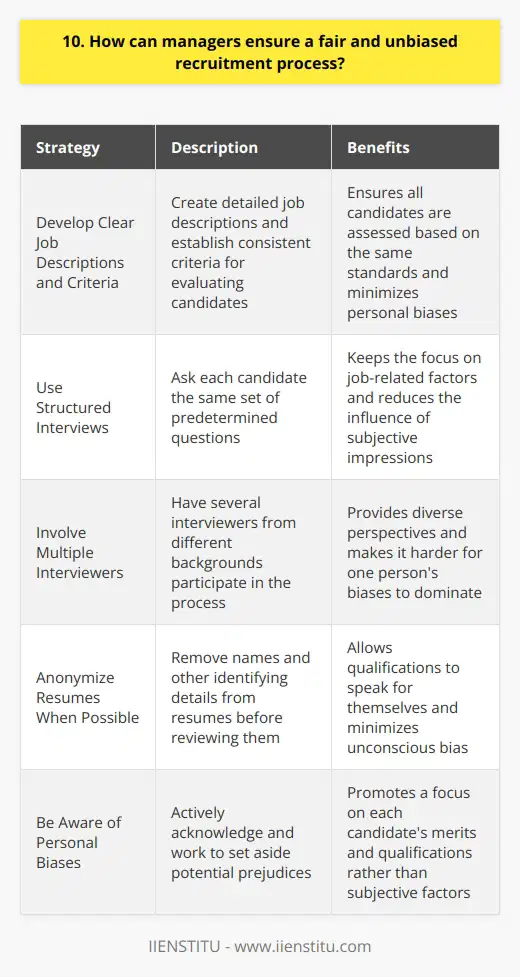
11. What are some effective onboarding strategies for new employees?
When it comes to onboarding new employees, I believe there are several effective strategies that can make a real difference. First and foremost, it's crucial to have a well-structured orientation program that introduces new hires to the company culture, values, and expectations.
Assign a Mentor or Buddy
In my experience, assigning a mentor or buddy to each new employee can be incredibly helpful. This person can serve as a guide and resource, answering questions and providing support as the new hire navigates their new role. I remember when I started my first job out of college, my mentor was invaluable in helping me understand the company's processes and procedures.
Provide Hands-On Training
Another effective strategy is to provide hands-on training opportunities. This could include job shadowing, where the new employee observes a more experienced colleague performing their job duties. It could also involve interactive workshops or simulations that allow the new hire to practice their skills in a safe environment.
Set Clear Goals and Expectations
I think it's also important to set clear goals and expectations from the very beginning. This helps new employees understand what is expected of them and how their performance will be measured. Regular check-ins and feedback sessions can help ensure that new hires are on track and feel supported.
Foster a Welcoming Environment
Finally, I believe that fostering a welcoming and inclusive environment is key to successful onboarding. This means making sure that new hires feel valued and appreciated, and that they have opportunities to connect with their colleagues on a personal level. Simple gestures like a welcome lunch or a personalized welcome gift can go a long way in making new employees feel at home.
Overall, effective onboarding requires a combination of structure, support, and inclusivity. By investing time and resources into this process, companies can set their new hires up for long-term success and retention.
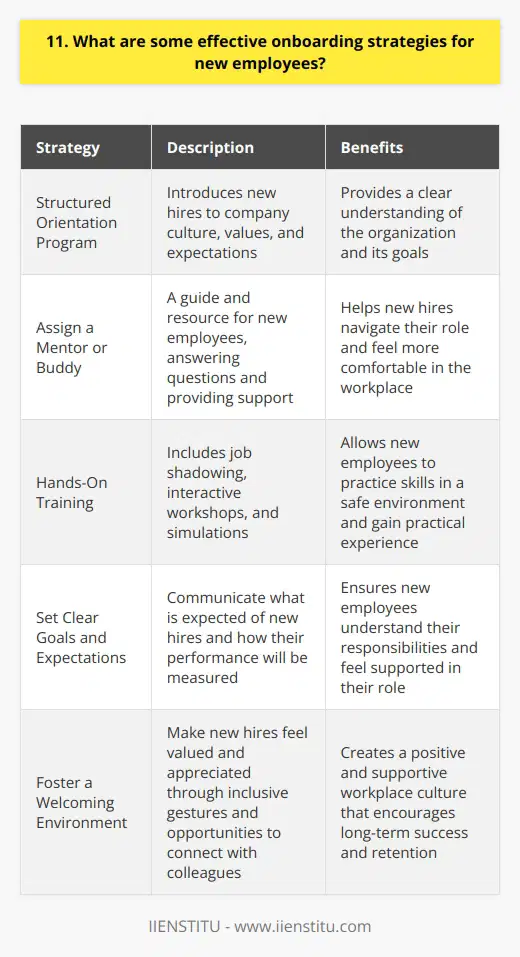
12. How can managers support their team's professional development?
As a manager, I believe that supporting my team's professional development is crucial for their growth and success. I make it a priority to have regular one-on-one meetings with each team member to discuss their career goals and aspirations. During these meetings, we identify areas where they want to improve and develop a plan to help them acquire the necessary skills and knowledge.
Providing training opportunities
I actively seek out training opportunities for my team, whether it's through online courses, workshops, or conferences. I encourage them to attend these events and provide them with the resources they need to succeed. I also create opportunities for them to apply what they've learned on the job, giving them projects that challenge them and allow them to showcase their new skills.
Mentoring and coaching
In addition to formal training, I believe in the power of mentoring and coaching. I make myself available to my team members whenever they need guidance or advice. I share my own experiences and insights with them, and I encourage them to do the same with each other. We have a culture of continuous learning and improvement, where everyone is encouraged to learn from one another.
Recognizing achievements
Finally, I believe in recognizing and rewarding my team's achievements. When someone masters a new skill or completes a challenging project, I make sure to acknowledge their hard work and success. This not only boosts their confidence but also motivates them to continue growing and developing in their careers.
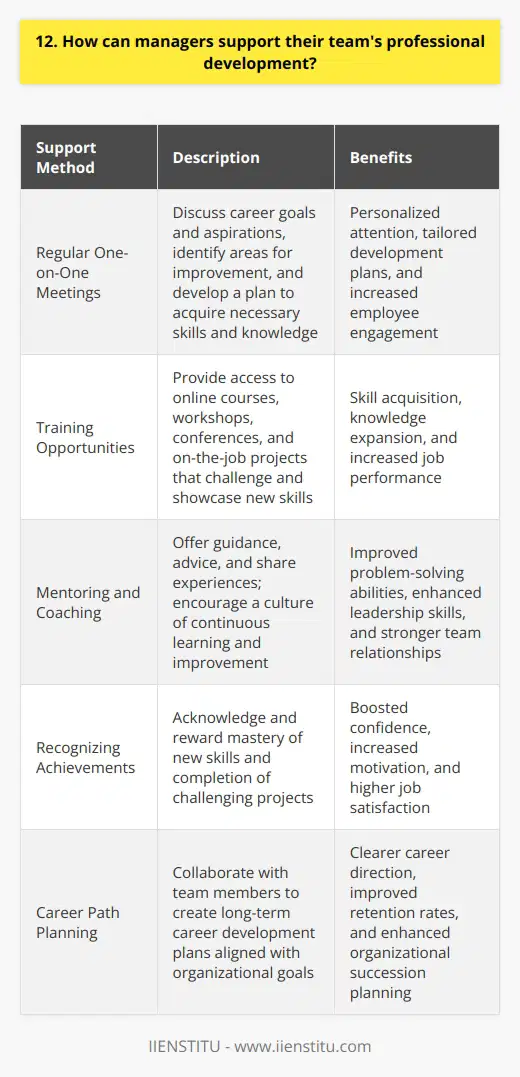
13. What are the key elements of a successful employee training program?
As an experienced HR professional, I believe that a successful employee training program should focus on several key elements:
Tailored to the Company's Needs
The training program must align with the company's goals and objectives. It should address specific skill gaps and challenges within the organization. When I worked at Acme Inc., we conducted a thorough needs assessment before designing our training curriculum.
Engaging and Interactive
Hands-on activities, group discussions, and real-world scenarios keep participants actively involved. I remember a particularly effective training session where we role-played customer service situations. It was both educational and fun!
Continuous Learning
Training shouldn't be a one-time event. It's important to provide ongoing opportunities for employees to learn and grow. At my current company, we offer regular workshops and e-learning modules to support continuous development.
Measurable Results
To gauge the effectiveness of the training program, it's crucial to establish clear metrics and track progress. This could include pre- and post-training assessments, employee surveys, or performance evaluations. I always make sure to set specific goals and measure outcomes to demonstrate the ROI of our training initiatives.
In my opinion, a well-designed employee training program is an investment in the company's most valuable asset - its people. By providing relevant, engaging, and ongoing learning opportunities, organizations can foster a skilled, motivated, and high-performing workforce.

14. How can managers handle underperforming employees?
When it comes to managing underperforming employees, I believe in a proactive and supportive approach. In my experience, the first step is to identify the root cause of the underperformance. Is it a lack of skills, motivation, or clear expectations? Once you understand the issue, you can develop a plan to address it.
Communication is Key
I've found that open and honest communication is essential. Schedule regular one-on-one meetings with the employee to discuss their performance and provide feedback. Listen to their concerns and ideas for improvement. Clearly communicate your expectations and the consequences of continued underperformance.
Provide Support and Resources
As a manager, it's important to provide the necessary support and resources for the employee to succeed. This may include additional training, mentoring, or tools to help them improve their performance. I remember a time when I worked with an underperforming team member who was struggling with time management. We worked together to create a daily schedule and prioritize tasks, which significantly improved their productivity.
Set Clear Goals and Milestones
Setting specific, measurable goals and milestones can help the employee stay on track and monitor their progress. Break down larger goals into smaller, achievable tasks. Regularly review their progress and provide feedback and recognition for improvements.
Consider the Team Dynamic
It's important to consider the impact of an underperforming employee on the rest of the team. If their performance is affecting team morale or productivity, it may be necessary to address the issue more directly. However, be cautious not to single out or embarrass the employee in front of their colleagues.
Know When to Let Go
Despite your best efforts, there may be times when an employee is unable or unwilling to improve their performance. In these cases, it may be necessary to consider termination. This decision should be made carefully and in consultation with HR to ensure compliance with company policies and legal requirements.
In summary, managing underperforming employees requires a combination of communication, support, goal-setting, and knowing when to make tough decisions. By taking a proactive and empathetic approach, managers can help their team members succeed and contribute to the overall success of the organization.
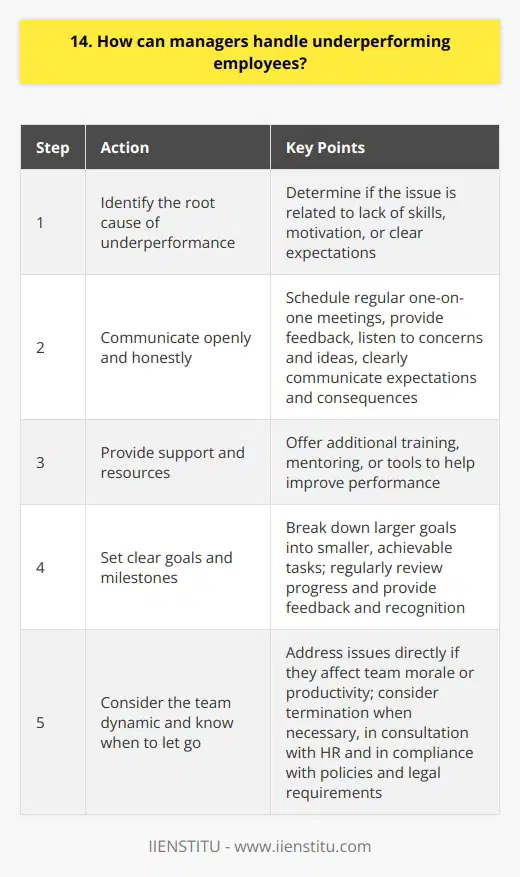
15. What are the best practices for employee retention?
As an HR professional with over a decade of experience, I believe that employee retention is crucial for any organization's success. Here are some best practices that I've found effective in keeping our valued team members engaged and motivated:
Foster a Positive Work Culture
Creating a supportive, inclusive, and enjoyable work environment is key to retaining top talent. Encourage open communication, celebrate achievements, and promote work-life balance. When employees feel valued and appreciated, they're more likely to stick around.
Offer Competitive Compensation and Benefits
To attract and retain the best employees, it's essential to provide competitive salaries and a comprehensive benefits package. Regularly review market rates and adjust compensation accordingly. Consider offering perks like flexible work arrangements, health insurance, and retirement plans.
Provide Growth Opportunities
Employees want to know that they have room to grow within your organization. Offer training programs, mentorship opportunities, and clear career paths. Encourage employees to take on new challenges and develop their skills. When they see a future with your company, they're more likely to stay long-term.
Recognize and Reward Performance
Regularly acknowledge and reward employees for their hard work and accomplishments. Implement a recognition program that highlights outstanding contributions. Offer bonuses, promotions, or other incentives to show your appreciation. When employees feel their efforts are valued, they're more engaged and loyal.
Foster Strong Relationships
Encourage strong relationships among team members and between managers and their direct reports. Host team-building activities, encourage collaboration, and promote open communication. When employees have positive relationships at work, they're more likely to feel a sense of belonging and commitment to your organization.
By implementing these best practices, you can create a work environment that encourages employee retention and helps your organization thrive.
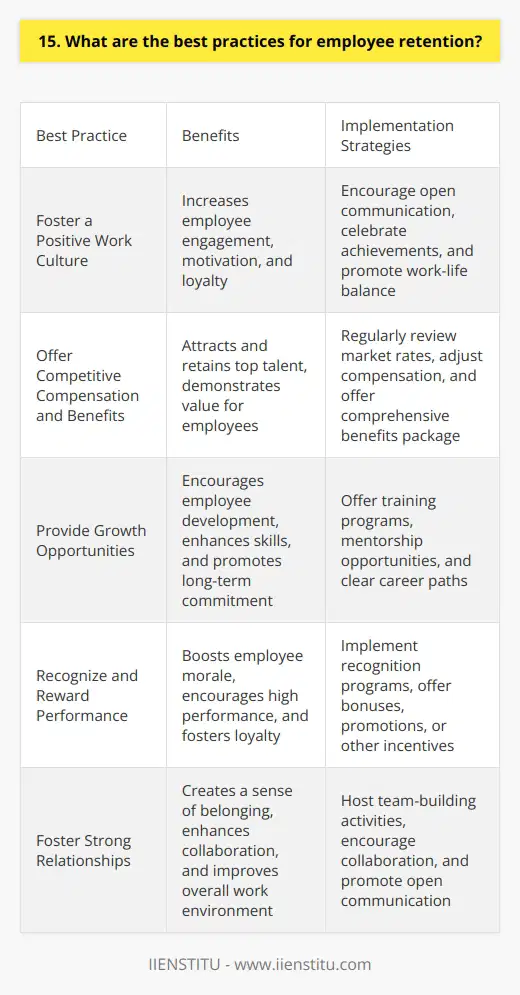
16. How can managers promote diversity and inclusion within their team?
As a manager, promoting diversity and inclusion within your team is crucial for creating a positive work environment. Here are some ways to achieve this:
Lead by Example
Managers must demonstrate their commitment to diversity and inclusion through their actions and words. Treat everyone with respect and value their unique perspectives. Be mindful of your own biases and work to overcome them.
Foster Open Communication
Encourage open and honest communication within your team. Create a safe space where everyone feels comfortable sharing their thoughts and ideas. Listen actively and value each person's contributions.
Provide Diversity and Inclusion Training
Offer training programs that educate your team about diversity, inclusion, and unconscious bias. These programs can help team members understand and appreciate differences, and learn how to work effectively with people from diverse backgrounds.
Celebrate Diversity
Recognize and celebrate the unique qualities and experiences that each team member brings to the table. Encourage team members to share their cultural traditions and celebrate diverse holidays and events.
Hire Diverse Candidates
When hiring new team members, actively seek out candidates from diverse backgrounds. This can help bring fresh perspectives and ideas to your team.
Provide Equal Opportunities
Ensure that all team members have equal access to opportunities for growth and advancement. Base promotions and assignments on merit and performance, not on personal characteristics or biases.
By implementing these strategies, managers can create a more inclusive and diverse team that values and respects all individuals. This not only improves employee morale and productivity but also helps the company succeed in today's global marketplace.

17. What are some effective ways to manage remote teams?
Managing remote teams effectively requires a combination of clear communication, trust, and the right tools. Here are some strategies I've found helpful in my experience leading distributed teams:
Establish Clear Expectations and Goals
Make sure everyone understands their roles, responsibilities, and what they need to achieve. Set specific, measurable targets. Have regular check-ins to ensure alignment and address any challenges or concerns that arise.
Communicate Frequently and Effectively
Since you can't just drop by someone's desk, it's important to overcommunicate. Use video calls for important discussions. Have a mix of team meetings and 1:1s. Provide timely feedback and recognition.
Build Trust and Connections
Remote work requires a foundation of trust. Assume positive intent and give people space to do their jobs. Make time for casual conversations and virtual team-building to foster relationships. Lead by example with transparency and follow-through.
Equip the Team with the Right Tools
Invest in reliable collaboration software for video conferencing, instant messaging, project management, and file sharing. Ensure everyone has the hardware and resources they need to be productive from home.
Managing remote teams has its challenges, but with the right approach, I believe distributed teams can be highly effective and engaged. The key is being intentional about communication, building a strong team culture virtually, and providing the tools and support people need to do their best work from anywhere.
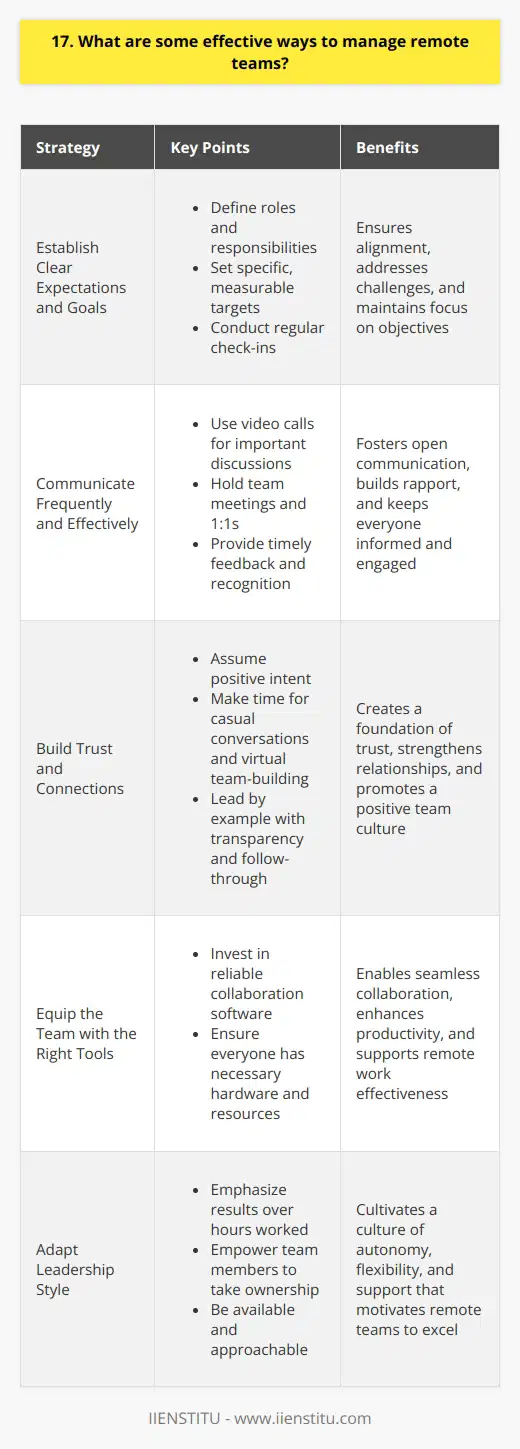
18. How can managers ensure compliance with HR policies and regulations?
As a manager, ensuring compliance with HR policies and regulations is crucial for maintaining a fair and productive workplace. Here are some strategies I would employ:
Lead by Example
I believe in setting a positive example for my team. By consistently following HR policies myself, I can demonstrate their importance and encourage others to do the same. When leaders walk the talk, it sends a powerful message.
Provide Regular Training
Offering frequent training sessions on HR policies keeps them fresh in everyone's minds. I would work with HR to develop engaging, interactive training programs that cover key topics like harassment prevention, diversity and inclusion, and proper conduct. Keeping the content relatable and memorable helps it stick.
Foster Open Communication
Creating an environment where employees feel comfortable asking questions and reporting concerns is essential. I would emphasize my open-door policy and regularly check in with team members. When people know they can come to you without judgment, they're more likely to raise issues before they escalate.
Enforce Policies Consistently
Consistent enforcement is key. Playing favorites or letting things slide sends mixed messages. I would strive to apply policies fairly across the board, regardless of a person's position or tenure. Consistent consequences show that the rules matter.
Stay Up-to-Date
HR regulations evolve over time. To ensure ongoing compliance, I would proactively partner with HR to stay informed about legal changes, industry best practices, and internal policy updates. Regular communication and collaboration between management and HR is the foundation of a compliant workplace.

19. What are the key components of a comprehensive employee handbook?
A comprehensive employee handbook is a crucial document that outlines company policies, procedures, and expectations. It serves as a guideline for both employees and employers, ensuring everyone is on the same page.
Key Components of an Employee Handbook
Company Mission and Values
The handbook should start by clearly stating the company's mission, vision, and core values. This helps employees understand what the organization stands for and what is expected of them.
Employment Policies
This section should cover topics such as equal opportunity employment, anti-discrimination, and harassment policies. It should also outline the hiring process, background checks, and eligibility requirements.
Compensation and Benefits
The handbook should provide details on pay schedules, overtime policies, and any available benefits. This includes health insurance, retirement plans, vacation time, and sick leave.
Code of Conduct
Every company has certain expectations for employee behavior. The handbook should clearly outline these expectations, including dress code, social media use, and confidentiality agreements.
Performance Evaluations
Employees should know how their performance will be measured and evaluated. The handbook should explain the performance review process and how it ties into promotions and raises.
In my experience, having a well-crafted employee handbook has been invaluable. It provides a sense of security and clarity for everyone involved. When I started my current job, the handbook was my go-to resource for any questions I had about company policies.
A comprehensive employee handbook is essential for any organization. It ensures everyone is aware of the company's expectations and helps create a positive work environment.

20. How can managers handle sensitive HR issues, such as harassment or discrimination?
As a manager, handling sensitive HR issues requires a delicate balance of professionalism, empathy, and decisiveness. When faced with allegations of harassment or discrimination, it's crucial to take the matter seriously and act swiftly to address the situation.
Listen and Investigate
The first step is to listen carefully to the employee's concerns and gather all relevant information. Conduct a thorough investigation, interviewing all parties involved and reviewing any available evidence. It's essential to remain objective and impartial throughout the process.
Maintain Confidentiality
Sensitive HR issues demand the utmost confidentiality. Ensure that all discussions and investigations are conducted privately, and emphasize the importance of discretion to everyone involved. Protecting the privacy of the employees is paramount.
Take Appropriate Action
Once the investigation is complete, take appropriate action based on the findings. If the allegations are substantiated, disciplinary measures may be necessary, ranging from warnings to termination, depending on the severity of the offense. Consistency is key to maintaining a fair and respectful workplace.
Provide Support
Throughout the process, offer support and resources to the affected employees. This may include counseling services, employee assistance programs, or referrals to external organizations. Showing genuine care and concern for their well-being can help foster a positive and inclusive work environment.
Prevent Future Incidents
To prevent future incidents, review and update company policies and procedures related to harassment and discrimination. Regularly train employees and managers on these policies and reinforce the importance of treating all individuals with respect and dignity. By proactively addressing these issues, managers can create a culture of inclusivity and professionalism.

21. What are some effective strategies for managing employee leave and absences?
As a manager, I believe that effective strategies for managing employee leave and absences are crucial. It's important to have clear policies in place that outline the procedures for requesting and approving time off.
Communicate Leave Policies Clearly
I make sure to communicate these policies to all employees during onboarding and regularly thereafter. This helps everyone understand their rights and responsibilities when it comes to taking leave.
Be Fair and Consistent
Fairness and consistency are key. I treat all leave requests equally, regardless of the employee's position or tenure. Favoritism can quickly lead to resentment and damage morale.
Plan for Coverage
Another strategy I use is to plan ahead for coverage when employees are out. Cross-training staff ensures that critical tasks can still get done even if someone is absent.
Encourage Open Communication
I also encourage open communication with my team about their leave needs. If someone is dealing with a personal issue that requires extended time off, I work with them to find a solution that meets both their needs and the needs of the business.
Use Technology to Track Leave
Finally, using a reliable system to track employee leave is essential. Whether it's software or a shared calendar, having a centralized place to manage requests and approvals keeps everyone on the same page.
By implementing these strategies, I've been able to effectively manage employee leave and minimize disruptions to our operations. It takes some planning and effort, but the payoff is a happier, more productive team.
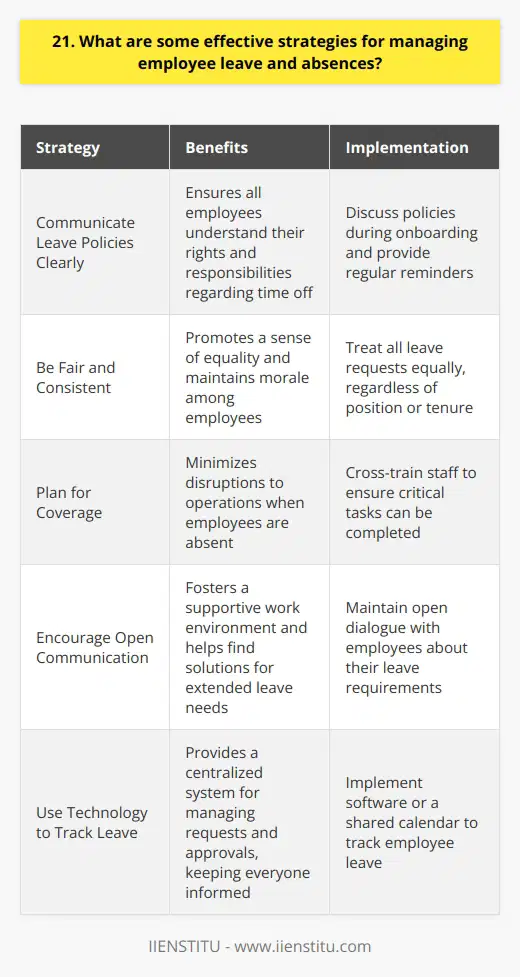
22. How can managers create a culture of continuous feedback and improvement?
Managers can create a culture of continuous feedback and improvement by leading by example. They should actively seek feedback from their team members and show genuine interest in their opinions. This encourages open communication and makes employees feel valued.
Encourage Regular Check-Ins
I've found that scheduling regular one-on-one meetings with each team member is incredibly effective. These check-ins provide an opportunity to discuss progress, challenges, and areas for improvement in a supportive environment. It's important to listen actively and provide constructive feedback during these sessions.
Celebrate Successes and Learn from Failures
When someone achieves a milestone or exceeds expectations, take the time to recognize their efforts publicly. Celebrating successes boosts morale and motivation. On the flip side, when mistakes happen, treat them as learning opportunities rather than pointing fingers. Encourage your team to analyze what went wrong and brainstorm solutions together.
Implement a Feedback Loop
Create a system where feedback is collected, analyzed, and acted upon consistently. This could involve regular surveys, suggestion boxes, or even a dedicated email address for improvement ideas. The key is to show that you value the input and are committed to making changes based on the feedback received.
Foster a Growth Mindset
Encourage your team to embrace challenges and view them as opportunities for growth. Provide resources and support for professional development, such as training programs or mentorship opportunities. When managers prioritize learning and development, it sends a powerful message that continuous improvement is valued within the organization.
Remember, building a culture of continuous feedback and improvement takes time and consistent effort. But by leading by example, encouraging open communication, and fostering a growth mindset, managers can create an environment where everyone feels empowered to contribute ideas and strive for excellence.
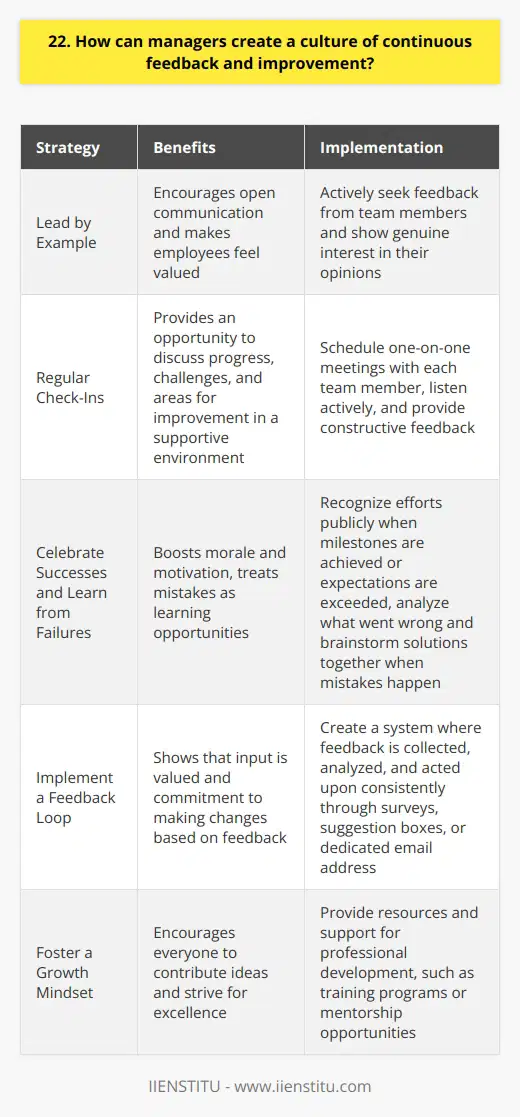
23. What are the best practices for conducting exit interviews?
When conducting exit interviews, it's crucial to create a comfortable and confidential environment for the departing employee. This encourages them to provide honest feedback about their experience working for the company.
Set Clear Objectives
Before the interview, determine what insights you hope to gain. Do you want to understand the reasons behind their departure? Are you looking for feedback on management, company culture, or specific processes? Having clear objectives helps guide the conversation.
Choose the Right Interviewer
Select an interviewer who is impartial and not directly involved in the employee's day-to-day work. This could be someone from HR or an external consultant. The interviewer should have excellent listening skills and be able to ask probing questions without making the employee feel uncomfortable.
Prepare Thoughtful Questions
Craft open-ended questions that encourage the employee to share their experiences and opinions. Avoid yes/no questions or anything that could be perceived as leading. Some example questions include:
Listen Actively and Take Notes
During the interview, give the employee your full attention. Make eye contact, nod, and encourage them to continue speaking. Take detailed notes so you can refer back to them later and identify common themes across multiple exit interviews.
Analyze and Act on Feedback
After conducting several exit interviews, review your notes and look for patterns. Are there recurring issues or concerns? Use this information to make meaningful changes within the organization. By acting on feedback, you demonstrate that you value employees' opinions and are committed to creating a better workplace.
Remember, exit interviews are just one piece of the puzzle. To get a complete picture of your company's strengths and weaknesses, combine insights from exit interviews with regular employee surveys and feedback sessions.

24. How can managers use HR data and analytics to make informed decisions?
As a manager, leveraging HR data and analytics is crucial for making informed decisions. By analyzing employee performance metrics, you can identify top performers and areas for improvement. This allows you to provide targeted training and development opportunities.
Identifying Trends and Patterns
HR analytics can also help you spot trends and patterns in employee behavior. For instance, high turnover rates in a particular department may indicate underlying issues that need addressing. By diving into the data, you can pinpoint the root causes and take corrective action.
Enhancing Recruitment Strategies
Moreover, HR data is invaluable for optimizing your recruitment strategies. By examining the characteristics of successful hires, you can refine your candidate selection process. This leads to better job-candidate fit and improved retention rates.
Making Data-Driven Decisions
In my experience, relying on gut instinct alone can be risky. I once hired a candidate who seemed perfect on paper but struggled to fit into our company culture. If I had analyzed our HR data more closely, I might have noticed red flags and avoided that mistake.
Since then, I've learned to base my decisions on a combination of data and intuition. By leveraging HR analytics, I can make more objective and informed choices that benefit both my team and the organization as a whole.
Continuous Improvement
Of course, using HR data effectively is an ongoing process. It requires regularly collecting, analyzing, and interpreting employee information. But the insights gained are well worth the effort. They enable managers to continuously improve their people strategies and drive better business outcomes.
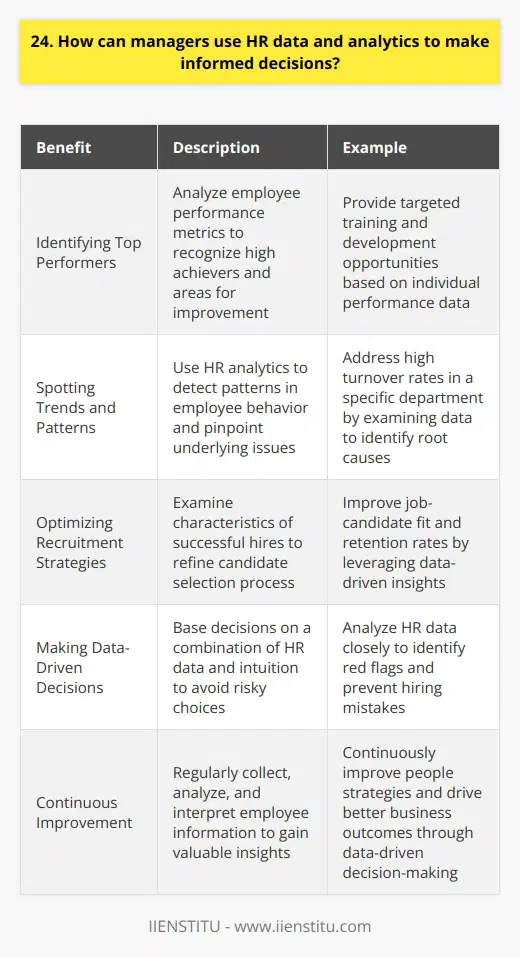
25. What are some effective ways to recognize and reward employee achievements?
Recognizing and rewarding employee achievements is crucial for maintaining a motivated and productive workforce. Here are some effective ways to do so:
Public Recognition
Acknowledge outstanding performance in front of colleagues, such as during team meetings or company-wide events. This boosts morale and encourages others to strive for excellence. I once saw a manager praise an employee's innovative idea during a department-wide presentation, and it was inspiring to see the pride on the employee's face.
Personalized Rewards
Tailor rewards to individual preferences, such as a gift card to their favorite store or an extra day off. This shows that you value their unique contributions and interests. I remember a colleague who loved hiking, and her manager surprised her with a new backpack as a token of appreciation for her hard work on a project.
Professional Development Opportunities
Offer training, workshops, or conference attendance to support employee growth and development. This demonstrates your investment in their long-term success. I had the chance to attend a marketing conference last year, thanks to my manager's recommendation, and it expanded my skills and network tremendously.
Monetary Incentives
Provide bonuses, raises, or profit-sharing plans to recognize exceptional performance and results. Money talks, and it's a tangible way to show appreciation for hard work. I once received a spot bonus for going above and beyond on a tight deadline, and it made me feel truly valued by my company.
Celebrate Milestones
Mark significant achievements or anniversaries with a special event or gift. This creates a positive culture of recognition and loyalty. My team once threw a surprise party for a colleague's 10-year work anniversary, complete with a heartfelt speech from our manager, and it was a memorable moment of camaraderie and appreciation.
By implementing a variety of recognition and reward strategies, you can create a workplace culture that values and celebrates employee achievements. It's not just about the reward itself, but the thought and effort behind it that makes employees feel truly appreciated and motivated to continue doing their best work.
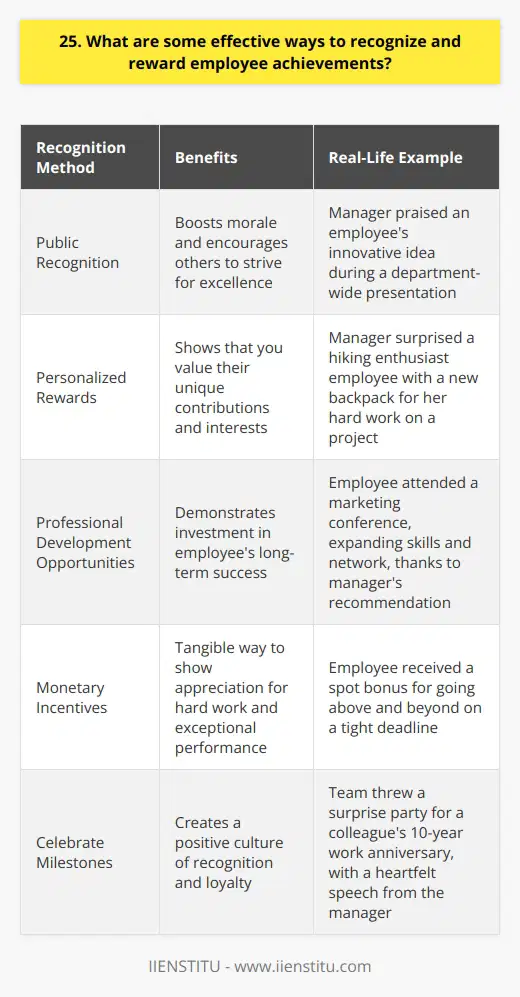
26. How can managers foster collaboration and teamwork among their employees?
As a manager, fostering collaboration and teamwork is crucial for the success of any organization. Here are some strategies I would implement:
Lead by Example
I believe in leading by example and demonstrating the importance of collaboration through my own actions. I would actively participate in team discussions, listen to everyone's ideas, and encourage open communication.
Create a Safe and Inclusive Environment
It's essential to create a safe space where all team members feel valued and respected. I would make sure that everyone has an opportunity to contribute their thoughts without fear of judgment or criticism.
Foster Open Communication
Encouraging open communication is key to building trust and facilitating collaboration. I would establish regular check-ins, team meetings, and one-on-one discussions to ensure that everyone is on the same page and feels heard.
Set Clear Goals and Expectations
Clearly defined goals and expectations help teams work together effectively. I would work with the team to establish shared objectives, roles, and responsibilities, ensuring that everyone understands how their individual contributions fit into the bigger picture.
Celebrate Successes and Learn from Failures
Recognizing and celebrating team successes helps boost morale and reinforces the importance of collaboration. At the same time, I believe in treating failures as learning opportunities, encouraging the team to reflect on what went wrong and how we can improve together.
By implementing these strategies, I believe I can foster a strong sense of collaboration and teamwork within my team, ultimately leading to better outcomes for the organization as a whole.
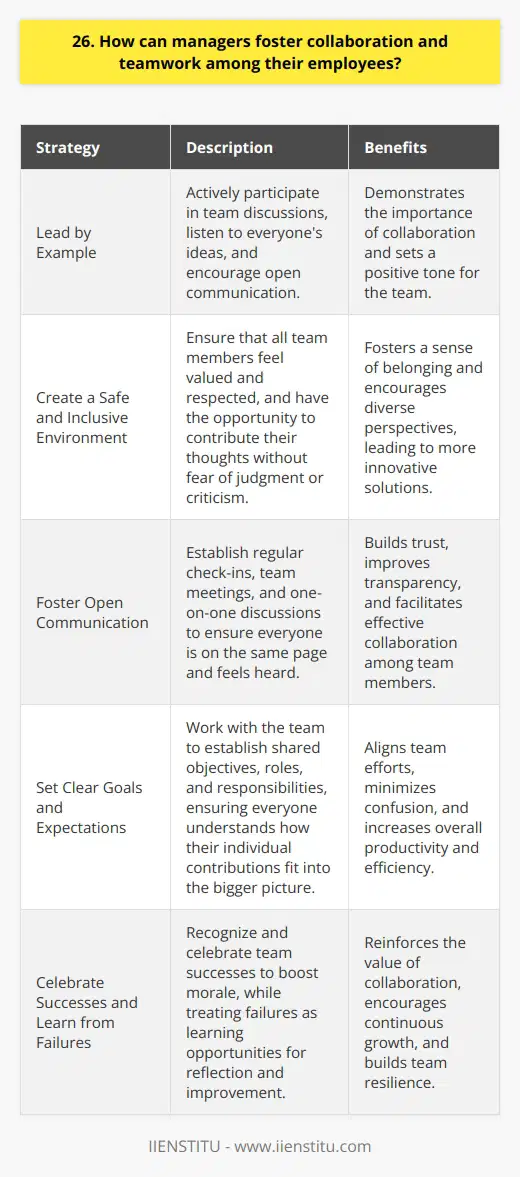
27. What are the key considerations when managing a multigenerational workforce?
When managing a multigenerational workforce, there are several key considerations I always keep in mind.
Recognize and Respect Differences
Each generation brings unique perspectives, values, and work styles. I strive to understand and appreciate these differences. For example, when I led a team with both Baby Boomers and Millennials, I learned that the Boomers preferred in-person meetings while the Millennials favored digital collaboration tools. By respecting both preferences, we found a balance that worked for everyone.
Facilitate Open Communication
Clear communication is essential for bridging generational gaps. I encourage open dialogue and actively listen to each team member. In one memorable project, I noticed some tension between an older employee and a younger new hire. By facilitating an honest discussion, we uncovered that the problem stemmed from different communication styles. The older employee preferred detailed explanations while the younger was used to brief, to-the-point messages. Once they understood each other better, they worked together much more smoothly.
Provide Tailored Training and Development
Different generations often have different learning preferences and career goals. I aim to provide customized training and development opportunities. When I mentored a Gen X employee looking to move into a leadership role, I recommended books and workshops that appealed to her learning style. For a Gen Z team member, I suggested online micro-courses and connected him with relevant networking groups. Seeing them grow and advance in their own ways has been incredibly rewarding.
At the end of the day, harnessing the strengths of a multigenerational team takes effort and care, but the diverse ideas and approaches lead to amazing results. I'm always excited to learn from colleagues of all ages and backgrounds. Together, we can achieve great things!

28. How can managers handle employee grievances and complaints?
As a manager, it's crucial to address employee grievances and complaints promptly and effectively. Here are some strategies to handle such situations:
Listen actively and empathetically
When an employee comes to you with a grievance, give them your full attention. Listen carefully to understand their perspective and show genuine concern for their well-being. I remember a time when one of my team members was visibly upset, and simply lending an ear helped them feel heard and valued.
Investigate thoroughly
Once you've listened to the employee's concerns, investigate the matter thoroughly. Gather information from all relevant parties and examine the facts objectively. In my experience, taking the time to conduct a comprehensive investigation demonstrates your commitment to fairness and helps you make informed decisions.
Communicate openly and transparently
Keep the employee informed throughout the process. Provide regular updates on the progress of the investigation and be transparent about the steps you're taking to address their concerns. I've found that open communication builds trust and helps employees feel more at ease during challenging times.
Seek solutions collaboratively
Work with the employee to find mutually agreeable solutions to their grievances. Encourage them to share their ideas and be open to compromise. I once had an employee who felt overwhelmed by their workload, and by collaborating with them, we were able to redistribute tasks and create a more balanced schedule.
Follow up and monitor progress
After implementing a solution, follow up with the employee to ensure their concerns have been adequately addressed. Monitor the situation closely and be prepared to make further adjustments if necessary. In my opinion, regularly checking in shows that you care about their well-being and are committed to creating a positive work environment.
Handling employee grievances and complaints can be challenging, but by approaching them with empathy, thoroughness, and a collaborative mindset, managers can foster a culture of trust and respect within their teams.

29. What are some effective strategies for managing employee compensation and benefits?
Effective strategies for managing employee compensation and benefits are crucial for attracting and retaining top talent. Here are some approaches I've found valuable in my experience as an HR manager:
Conduct Regular Market Research
Staying up-to-date on industry benchmarks for salaries and benefits packages is essential. I make it a point to review compensation data at least annually to ensure our company remains competitive.
Align with Company Goals and Values
Compensation and benefits should support the overall mission and objectives of the organization. For example, if innovation is a core value, consider offering rewards for employees who generate new ideas that improve processes or products.
Communicate Clearly and Transparently
Employees appreciate knowing how their pay is determined and what benefits they're entitled to. I've found that holding regular info sessions and providing easy-to-understand handouts helps build trust and engagement.
Offer Flexibility and Customization
One size doesn't fit all when it comes to comp and benefits. Giving employees some choice, like picking from several health plans or deciding between more vacation days or a higher bonus percentage, can boost satisfaction.
Monitor and Measure Effectiveness
It's important to track key metrics like turnover rates, employee satisfaction scores, and total compensation costs. This data helps identify what's working well and where adjustments may be needed.
At the end of the day, thoughtfully designed and well-managed compensation and benefits programs are an investment in your most valuable asset - your people. The extra effort is worth it to build a motivated, loyal team.

30. How can managers stay updated on the latest HR trends and best practices?
Staying Informed Through Industry Resources
I believe it's critical for managers to stay current on the latest developments and innovations in human resources. One effective way to do this is by regularly reading leading HR industry publications and blogs like HR Magazine, Workforce, HR Daily Advisor, and SHRM's HR Today. These resources offer timely articles on new trends, regulatory changes, case studies, and best practices that can inform HR strategies.
Attending HR Conferences and Events
Another valuable way to stay updated is attending HR conferences, workshops, and networking events. I've gained so many useful insights from sessions at events like the HR Technology Conference and the SHRM Annual Conference. Hearing directly from thought leaders and practitioners and swapping ideas with peers is incredibly enriching. Webinars can also be an efficient way to learn about specific HR topics without the time and expense of travel.
Connecting with an HR Network
Building relationships with a network of HR professionals, whether locally or online, is hugely beneficial. I'm a member of a regional HR management association where we meet monthly to discuss challenges and share knowledge. Having trusted colleagues to bounce ideas off of and learn from has been invaluable in my career. Social networks like LinkedIn groups are also great for virtual discussion and accessing a wider pool of expertise.
By tapping into industry publications, events, and networks, I believe HR managers can stay on the cutting edge. We have a responsibility to continually educate ourselves so we can be the best strategic partners to our organizations.



